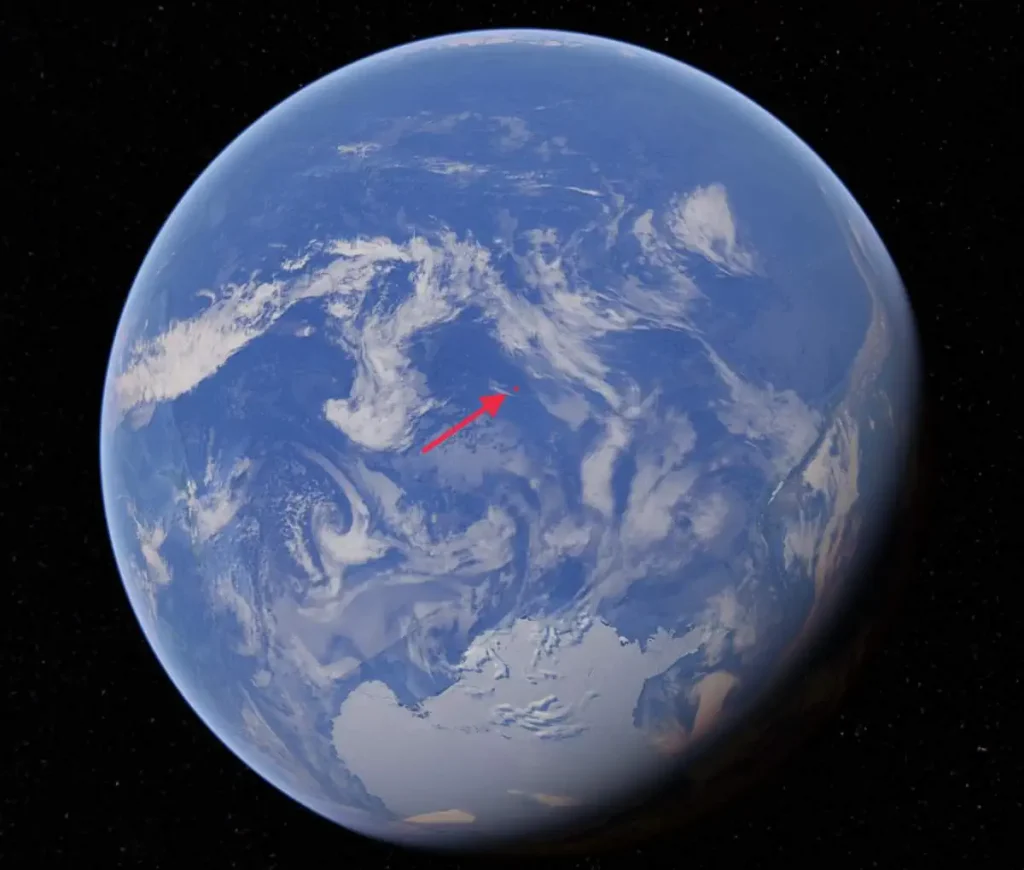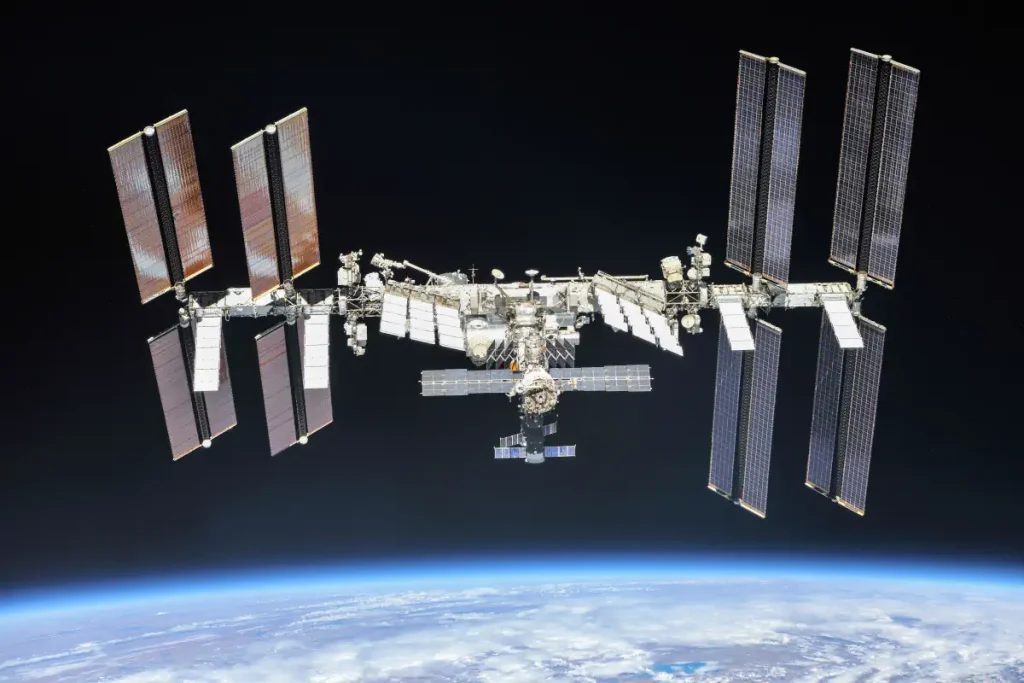In the middle of the South Pacific Ocean, there’s a location called “Point Nemo”. It’s not a place where humans live, in fact, there is no land there: not an island, not even a small rock. It is actually the remotest place from any human civilization you can find on Earth. It lies at least 2,688 km (1,670 mi) from the nearest land. It is also called the “Oceanic Pole of Inaccessibility” (see notes 1).
Point Nemo, Latin for “no one” is also a reference to Jules Verne‘s Captain Nemo, a fictional character who appears in two of Verne’s novels, Twenty Thousand Leagues Under the Sea (1870) and The Mysterious Island (1874), and makes a cameo appearance in Verne’s play Journey Through the Impossible (1882). Its remoteness is the reason why NASA uses the point as its “spacecraft cemetery”.

Point Nemo, where old spacecraft go to die
Not only the farthest location from human civilization, but Point Nemo is also “relatively lifeless”. Its location within the South Pacific Gyre blocks nutrients from reaching the area. Furthermore, being so far from land, it gets little nutrient run-off from coastal waters. These are the reasons (of course the most important reason is its remoteness) why NASA chose the location to deposit hundreds of decommissioned spacecraft: satellites, space stations, etc.
The remoteness of Point Nemo lessens the risk of any “dead” spacecraft hitting any inhabited locations upon re-entering the atmosphere. According to Popular Science, space agencies all over the world dumped over 263 spacecraft into the region between 1971 and mid-2016, and the number is continually growing. In the year 2015, the total was just 161.
“Russian objects far outnumber every other space agency when it comes to the Pacific Ocean; there are more than 190 Russian objects alone. The US is next with 52 objects, then Europe with 8, Japan with 6, and finally SpaceX dropped its second stage here in September of 2014.” (Source: Popular Science)
In fact, many smaller satellites don’t end up in Point Nemo. They enter the atmosphere with a velocity of at least a few kilometers/miles per second. So, the heat generated by the air friction burns up the satellite, like the small meteorites which never reach the Earth’s surface.
Some interesting Point Nemo facts
- Point Nemo didn’t officially exist until 1992. In 1992, Croatian-Canadian survey engineer Hrvoje Lukatela used a geospatial computer program and calculated the most remote ocean point. He realized that it must be equidistant from three different coastlines. Today, Lukatela is known as “The discoverer of the Point Nemo” but he never actually went there.
- Point Nemo is so far from land, the nearest humans are often astronauts aboard the International Space Station (ISS). The ISS orbits the Earth at a maximum of 258 miles (416 kilometers). Meanwhile, the nearest inhabited landmass to Point Nemo is over 1,670 miles (2,700 kilometers) away.
- Interestingly, Point Nemo is also biologically not very diverse. It sits within a current called the South Pacific Gyre, which steers away nutrient-rich waters, making it one of the most lifeless parts of the ocean.
- Despite being the most remote oceanic spot it’s still awash with plastic. According to a report on The Guardian, up to 26 microplastic particles per cubic meter were found in seawater samples collected near Point Nemo by passing vessels taking part in the Volvo Ocean Race.
- By far the largest object descending from the heavens to splash down at Point Nemo was Russia’s MIR space station, which weighed 130 tonnes. Mir was the first modular space station that operated in low Earth orbit from 1986 to 2001.
- The massive, 420-tonne International Space Station (ISS), the most expensive object ever constructed also has a rendezvous with destiny at Point Nemo, sometime after 2025.

Not all spacecraft end up in Point Nemo
Most spacecraft end up in Point Nemo, but there are exceptions too. For example, China’s out-of-control space station, Tiangong-1, did not crash on Point Nemo.
Tiangong-1 launched on 29 September 2011, and its operational life cycle was predicted at two years. On 21 March 2016, after its lifespan was extended by two years, the Space Engineering Office of China announced that they had disabled data service since the space station had operated for two and half years longer than its intended two-year service plan.
The officials went on to state that the telemetry link with Tiangong-1 had been lost. But, a couple of months later, amateur satellite trackers watching Tiangong-1 began to speculate that China’s space agency had lost control of the station. In September, after conceding they had lost control over the station, officials announced that the station would re-enter and burn up in the atmosphere in April 2018.

Harvard astrophysicist Jonathan McDowell, among others, told the British daily newspaper The Guardian that parts of the craft such as the rocket engines are probably too dense and tough to be burnt up upon re-entry and may result in chunks of debris up to 100 kg (220 lbs) in weight falling to the Earth’s surface, with little possibility of predicting where they may crash.
The 8.5-tonne spacecraft reentered the Earth’s atmosphere at approximately 00:16 UTC on 2 April 2018 over the South Pacific Ocean a 24.5 °S 151.1 °W. This was about 3,600 kilometers (1,900 nautical miles) from Point Nemo. As the spacecraft made an uncontrolled reentry, this was an unintended coincidence.
According to the Chinese state news agency Xinhua, the station mostly burnt up upon re-entry. A fisherman from the nearby island of Maupiti was able to witness the event. It was the largest spacecraft to re-enter the atmosphere since Fobos-Grunt (see notes 2) in January 2012.

Related: What happens to old spacecraft?
In fact, every few years, uncontrolled spacecraft of this size enter the Earth’s atmosphere.
For example, the 5,900-kilogram (13,000 lb) NASA-operated orbital observatory Upper Atmosphere Research Satellite (UARS) decommissioned and re-entered Earth’s atmosphere on 24 September 2011. It ultimately impacted a remote area of the Pacific Ocean. Some decommissioned spacecraft have returned so remotely that there was no visual evidence of their fall.

Largest uncontrolled spacecraft reentries
Spacecraft | Reentry mass (in tonnes) | Date | Location
- Apollo BP-13/Saturn SA-6 | 16.2 | June 1, 1964 | Pacific Ocean
- Almaz-1 space station (Salyut-2) | 16.3 | May 28, 1973 | Pacific Ocean, near Fiji
- Apollo BP-15/Saturn SA-7 | 16.4 | September 22, 1964
- N-6 No. 1 satellite (Proton-4) | 17.0 | July 24, 1964 | Unknown
- Saturn SA-5 rocket/Jupiter nosecone | 17.2 | April 30, 1966 | Brazil
- DOS 3 space station (Kosmos-557) | 18.5 | May 22, 1973 | Indian Ocean
- DOS 6 space station/TKS-M module (Salyut-7/Kosmos-1686) | 39.0? | February 7, 1991 | Argentina
- Saturn S-II-13 (Skylab rocket) | 45.1 | January 11, 1975 | Atlantic Ocean (west of Madeira)
- Skylab space station | 75.7 | July 11, 1979 | Australia
- OV-102 Space Shuttle Columbia (STS-107) | 106.4 | February 1, 2003 | Texas/Louisiana
Point Nemo Location
The coordinates of Point Nemo are: 48°52’36.0”S 123°23’36.0”W (48 degrees 52 minutes 36 seconds south latitude and 123 degrees 23 minutes 36 seconds west longitude)
The location of Point Nemo (or the Oceanic pole of inaccessibility) on Google Maps.
Notes
- A pole of inaccessibility often refers to the most distant point from the coastline, implying a maximum degree of continentality. For example, the northern pole of inaccessibility, sometimes known as the Arctic pole of inaccessibility, or just the Arctic pole, is located on the Arctic Ocean pack ice at a distance farthest from any landmass. It is 1,008 km (626 mi) from the three closest landmasses. The southern pole of inaccessibility is the point on the Antarctic continent most distant from the Southern Ocean. A variety of coordinate locations have been given for this pole. The discrepancies are due to the question of whether the “coast” is measured to the grounding line or to the edges of ice shelves, the difficulty of determining the location of the “solid” coastline, the movement of ice sheets, and improvements in the accuracy of survey data over the years, as well as possible topographical errors. It commonly refers to the site of the Soviet Union research station, which was constructed at 82°06’S 54°58’E (though some sources give 83°06’S 54°58’E). This lies 878 km (546 mi) from the South Pole, at an elevation of 3,718 meters (12,198 feet). Using different criteria, the Scott Polar Research Institute locates this pole at 85°50’S 65°47’E. According to ThePoles.com, the point farthest from the sea accounting only for the Antarctic land surface proper is at 82°53’14″S 55°4’30″E, and the farthest point when ice sheets are taken into account is 83°50’37″S 65°43’30″E. These points, calculated by the British Antarctic Survey, are quoted as being “the most accurate measure available” (as of 2005). Either way, the southern pole of inaccessibility is far more remote and difficult to reach than the geographic South Pole.
- Fobos-Grunt or Phobos-Grunt (Russian: Фобос-Грунт, literally “Phobos-Ground”) was an attempted Russian sample return mission to Phobos, one of the moons of Mars. It was launched on 9 November 2011 at 02:16 local time (8 November 2011, 20:16 UTC) from the Baikonur Cosmodrome, but subsequent rocket burns intended to set the craft on a course for Mars failed, leaving it stranded in low Earth orbit. Efforts to reactivate the craft were unsuccessful, and it fell back to Earth in an uncontrolled re-entry on 15 January 2012, over the Pacific Ocean west of Chile.
Sources
- “The Place Furthest from Land is known as Point Nemo” on BBC Earth
- Captain Nemo on Wikipedia
- Tiangong-1 on Wikipedia
- Point Nemo on Wikipedia
- Point Nemo on Atlas Obscura
- 8 facts about Point Nemo on the Volvo Ocean Race website
- Point Nemo, Earth’s watery graveyard for spacecraft on Phys.org
- “Point Nemo is the most remote oceanic spot – yet it’s still awash with plastic” on The Guardian
- Fobos-Grunt on Wikipedia
- Moon Landings: All-Time List [1966-2025] - February 2, 2025
- What Is Max-Q and Why Is It Important During Rocket Launches? - January 16, 2025
- Top 10 Tallest Rockets Ever Launched [2025 Update] - January 16, 2025
